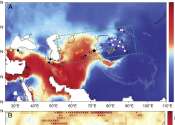Scientists reveal hydroclimatic changes on multiple timescales in Central Asia over the past 7,800 years
A recent study published in the PNAS shows that western Central Asia has experienced a long-term drying trend over the past 7,800 years. This discovery, based on the analysis of a stalagmite from the Fergana Valley in Kyrgyzstan, ...









